Lobetal – In food chains
I am currently investigating gardening, farming and farming methods a little more in depth than before. And no – I don’t mean here playing FarmVille on facebook.
That is amongst others I am part of a little urban gardening project, in which I am in charge for a couple of veggie and herb beds, which shall supplement our own nutrition. Gardening and farming is rather labour intensive, however for me it was an acessable way to eventually contribute to the families income (at the moment it though looks actually still rather as a minus effort), but even if some work is strenous it is nice to be outside in fresh air (unfortunately they are planning to enlarge the big highway in the vicinity, so this “fresh air” aspect will probably decrease). Moreover farming methods are important within the global climate and in the distribution of resources, something I currently still look at.
I am also trying to somewhat connect to the local (urban) farming community. Like there is a Berlin project called 2000 squaremeters which is partly connected with the project Wilde Gärtnerei etc.
Why that strange name “2000 squaremeters”?
If one downloads the table about the global availability of arable land per person and country at world bank and performs the sum over all countries in some table calculation program then one can find out that there are currently roughly 2000 squaremeters of arable land for every person in the world. There is though in addition also agricultural land, which includes trees and bushes for harvest and permanent pastures. I think that number is amongst others also mentioned in the Fao food report.
So what does those 2000 m^2 really mean ?
There was recently a news report by Badische Zeitung, which indicated that an average almost veggie german needs for his/her food consume about 2500 m^2 land, which I found quite disconcerting with respect to the above mentioned 2000 m^2 of arable land. I asked therefore the Landesanstalt LEL for more information on that topic and they friendly sent me a link to the original research article. If I understood correctly the calculated 2500 m^2 are not really the land need for an “almost veggie” average german but rather for the current average german food consumption (with organic farming methods, the percentage of food waste is unclear to me). So in particular this includes meat and it includes a food consume, which may be partially unhealthy. In particular of the 2500 m^2 almost all (2.143 m^2) are needed for producing animal food products, like milk and meat. If one would reduce those to a recommendable level (where “recommendable” is of course debatable) than those would only require 1.081 m^2, i.e. the land need would be roughly half the size:
Wie würde der Flächenbedarf aussehen, wenn nur so viel tierische Lebensmittel wie empfohlen gegessen würden? Basierend auf den von Woitowitz (2007) berechneten verringerten Verzehrmengen ermittelt die Studie einen halbierten Flächenbedarf für die Produktion tierischer Produkte; er reduziert sich von 2.143 auf 1.081 Quadratmeter (Tab. 2).
The land need of a german is thus in particular currently more than the existing 2100 m^2 agricultural land in Germany:
Rein rechnerisch stehen einem deutschen Bürger aber nur zirka 2.100 Quadratmeter landwirtschaftlicher Fläche zur Verfügung (2007/2008,BMELV, 2009).
In short: the above numbers show that- in view of a growing population- it’s getting somewhat tight even for food ressources on a global level. A fact which gets intrinsically also visible if one notices facts like that there are already countries which buy up farm land in other countries eventually in order to ensure the nutrition of their own population. As far as I know Germany hasn’t done that yet but is currently still relying on exchanging e.g. machines for food.
Moreover as everybody knows, despite those already tight conditions – at least in parts of Europe – people still try to get into Europe and actually these days there where almost riots, due to refugees, who claimed their right for living space in central Berlin.
In this context I attended last weekend a tour, which was organized by the Berlin organic food delivery Märkische Kiste, which went to a town called Lobetal which has an interesting history – in particular it hosted a socalled “worker colony”. That is at the beginning of the century there where a lot of unemployed and homeless people desperately pouring into and roaming through Berlin. Pastor Friedrich von Bodelschwingh had founded the foundation “Bethel”, which organized among others this worker colony in Lobetal. Although the there offered living space was rather a cupboard and although the work was hard and apart from food and living basically no other incentives were offered the colony was more or less flooded with desperate workers. In later years though there was reduced unemployment (in particular the Nazi’s initialized big working opportunities, like by building the Autobahn) and the colony turned rather into a home for disabled and old persons, which it still is. In particular Lobetal offers jobs for disabled and mentally retarded persons and also for victims of drug abuse. Two of the various working facilities for those persons at Lobetal are the farm and the dairy, which we visited.
The tour participants got a very interesting tour into the farm by Dr. Hartmann and into the dairy by Michael Kuper.
Some interesting facts (which I hope remember correctly):
The agrable land in Lobetal is almost completely used for food production for cattle. The cattle need about 2-3 years to grow up. Then they are annually inseminated, so they ought to reproduce once a year and ought to give milk. This happens for about 5-6 years, after that they are send to the slaughterhouse. Without slaughtering the farm wouldn’t be really financially feasable as I understood. The cattle fecies are used for fertilization.
In the dairy the milk is aggregated from the Lobetal site and from another site and mostly turned into very tasty yoghurt. There are about 23 disabled persons (called “Beschäftigte” working at the dairy and 8 other employees (called “Mitarbeiter”). The dairy is really quite high tech. The Beschäftigten are mostly occupied with folding cardboards, in which the yoghurt is placed into and they are occupied with placing the Yoghurt into the folding box and with simple cleaning and other requirements. There are two Beschäftigte who can read and they help to assemble orders. Most part of the machinery can’t be operated by the Beschäftigten, moreover there are strict work hour restrictions for them, so that if something goes wrong the 8 MItarbeiter need to do also the cardboard folding. There were interesting visual signs for the Beschäftigten, like a socalled “red card”, which was a big red card and which said “It’s enough”. Apparently there are some quarrels once in a while. The state pays 9 Euro’s per day for the integration of each Beschäftigten and the Beschäftigten get a monthly salary of 100-300 Euro’s depending on performance and conduct (like if they appear clean to work etc.). All work opportunities of the foundation are non profit. The people at the dairy try to vary the tasks for the Beschäftigten, however there are also Beschäftigte who refuse to stop cardboard folding. It is actually a task which needs quite some learning and which might be quite challenging and the Beschäftigten are often proud that they manage this task.
But back to the cattle. Concluding the cattle are allowed to live for 5-6 years (If they produce enough milk). The barn looks airy and clean and the cattle can also roam out into the pastures if they want (which is in high contrast to a lot of other barns). So apart from the need to reproduce, (frequent pregnancies are of course strenous) and the restricted life-time they are at least allowed to live a what on a first glance “looks like” halfway decent life. I.e. a lot of cattle get a “life”, which they wouldn’t get if all humans would use up all the rest arable land for their vegan life. Apart maybe from some exceptions in zoos and resorts and apart maybe from India and similar countries, where cattle are holy and where they have even old-care homes for cattle, socalled Gaushalas. It should though be said that the food for the cattle in India is already in competition with food for (usually) more intelligent humans. (Where one has to acknowledge that some of the cattles products are used for feeding humans and machines that is apart from the milk the fecies of the cattle are also used for biofuel.) And more important – I don’t know in how far the reproduction of cattle is controlled in India.
I wrote above in quotation marks that it “looks like” as if the cattle are living a somewhat livable life in Lobetal not only for the reason that it is quite hard to tell how the cattle really feel, but also because I haven’t (yet) looked into the slaughterhouse. In particular it seems the current methods of anesthetizising are mostly via CO2, which apparently leads to feelings of suffocation and a rather terrible mortal agony. There are therefore currently methods in discussion which would use helium instead of CO2 (warning: this video of CO2 anesthetizising in a slaughterhouse is not easy to watch.)
By the way the pastors in Lobetal were mostly successful in preventing that their disabled persons were deported within the Euthanasie program of the Nazi’s:
The person’s ability to work is one of the criteria in the categorization process.
There were though also some jews living at Lobetal, some of them (7) were unfortunately detected and deported into death camps.
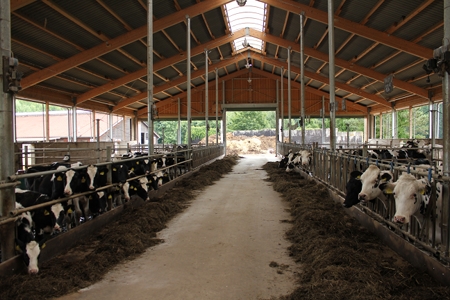
airy cattle barn at Lobetal, everything can be easily monitored
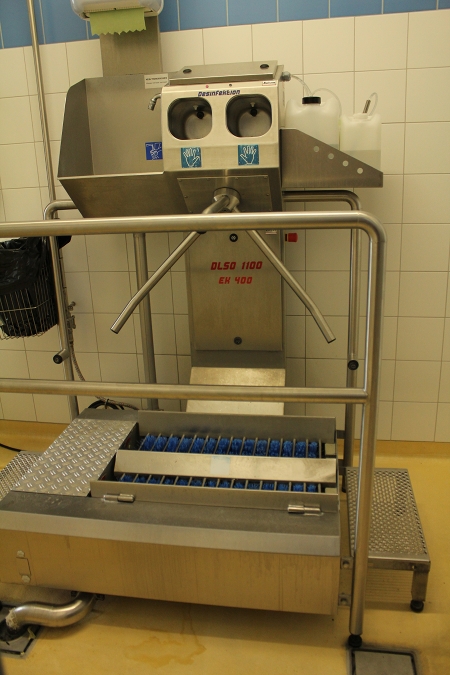
current desinfection facility for Mitarbeiter and Beschäftigte at the dairy
update 19.04.2016:
I meanwhile see the above mentioned initiative 2000 m^2 rather critical in particular the initiative 2000 m^2 has now -probably in the context of the international garden exhibition IGA- set up a fenced field within Erholungspark Marzahn. The set up is in an area which was until last year a free of entry public recreational space (The area had been used for hiking and skiing and it hosted Marzahns most popular and basically one and only big sledging hill). Main sponsor of the IGA is the company Nestlé.
update 11.6.2017:
For those who understand german here a short documentation on Tagesschau which displays a conventional dairy farm with an automatized screening of the about 400 cows.
update 21.10.2017
I meanwhile visited the IGA. For a garden exhibition it was fairly OK, although one could have made many things differently. I visited also the field of the 2000m^2 initiative, which is now called “Weltacker” (german for “world field”).
Accidentally while I was there a tour by “the” or “one of the” initiatives leaders was given and I joined in. I made some disagreeing remarks but I was told not to disturb the tour too much.
I described the remarks in a comment to a Google Plus post by John Baez. For a copy of the comment please see below.
As it turned out the company Nestlé was probably only a main commercial sponsor. That is the city of Berlin has to pay a lot of money in order to balance the debt that had been made with the IGA. The IGA has now terminated and I still hope that the sledging hill will be made again accessible to the public.
Here the comment to John Baez Google Plus post:
+John Baez
+Bob Haugen
+rasha kamel
I was recently complaining at a project here in Berlin called “Weltacker” https://www.2000m2.eu/ that in all those discussions I have seen sofar (including the ones you link to) nobody seems to pay really attention to the needed workforce for the corresponding farming methods. The Weltacker project (it was last located at the International Garden Exhibition in Berlin) is a public awareness project at which the current size of worldwide available arable land per person, (which is about 2000 m^2 https://data.worldbank.org/indicator/AG.LND.ARBL.HA.PC?name_desc=true) is proportionally planted with crops according to their respective worldwide avarage distributions. I took part at a tour where the tour leader (who happened to be also the project lead I think) was – like the articles- complaining about current big farming methods and moreover that too much soil goes into biofuel. So that I felt the need to ask: “I agree that biofuel is very inefficient, but on the other hand did you monitor how much workforce went into your project, including mechanical work by machines and humans?” No they didn’t and worse this discussion was considered to be not so important, (likewise again in those articles).
But I think this debate is crucial, because one of the major threats for the future size of arable land per person is overpopulation:
blogs.worldbank.org – The future of the world’s population in 4 charts
Easy calculation: in 2011 the avarage arable land was 1990 m^2 and the world population 7.013 billion. So for about 11.3 billion people in about the year 2100 one gets 7.013*1990m^2:11.3=1235.03m^2
(…assuming that the worldwide size of arable land stays constant (which is quite an optimistic assumption)).
As a comparion the current land need for a german nutrition is about 2500 m^2.(http://www.randform.org/blog/?p=5594).
Moreover it is clear that animals in food production are apriori a mean for food energy storage. There are basically no crops growing in winter time in northern countries. So with a pure vegetarian diet one would need to massivels think about very energy intense storage/greenhouse plantations for veggies and/or southern countries would need to feed the northern ones…….(no comment)
So this is the big elephant in the room.
And one reason for this popuation growth is that (current) agriculture needs a lot of workforce. And if you don’t have fueled machines you need a lot of people. Think about the Amish people and how they need many kids to help them out.
Moreover I did a quick back-of the enveloppe calculation for the land need of humans versus current photovoltaics for the same amount of workforce http://www.randform.org/blog/?p=5936 and got a factor of 560….
That is to use human energy instead of electric via solar means 560 times more land need, if I didn’t make a mistake in the calculations (please check back).
So this is another elephant in the room.
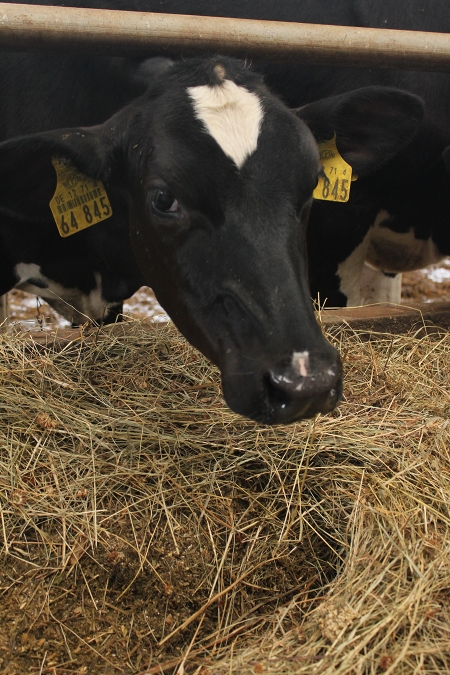
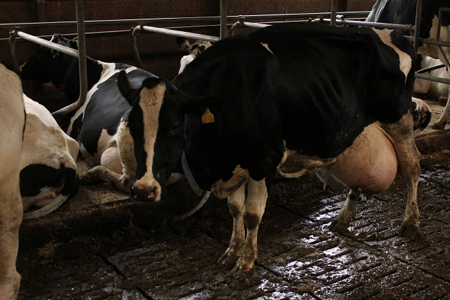
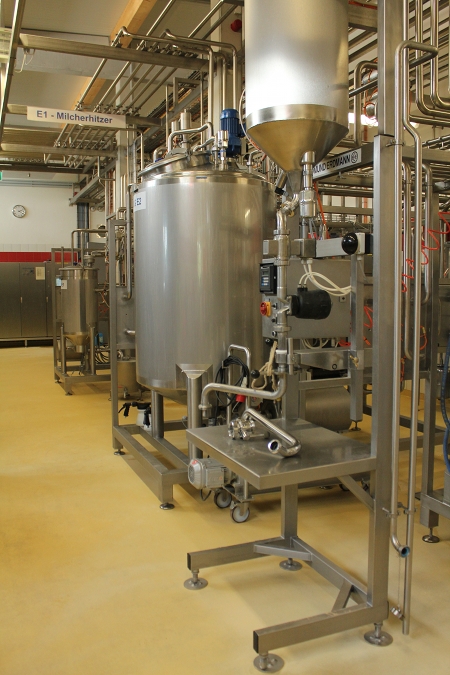
July 5th, 2014 at 9:55 am
Ick kann och keene Euta von die Nähe seen.
July 31st, 2014 at 8:19 am
Hard farming work in exchange for food and living? Isn’t that exploitation?
October 24th, 2014 at 3:20 pm
Who gives you the right to judge that more intelligent humans are more eligible to ressources than cattle! Finally and last but not least: the “more intelligent humans” are quite able to defend their rights in contrast to the cattle!
December 5th, 2014 at 9:38 am
If I look at this milk-cow image above then -sorry- but I can’t help asking myself, why on earth is that cow not wearing a bra?
March 26th, 2015 at 11:22 am
I understand that there are economical constraints, but ethically I do see problems here. Boosting animal intelligence might eventually be a way. Like this golden retriever could eventually also find a place in the entertainment industry.
May 15th, 2015 at 10:00 am
Frankly I think this cattle should not only wear a bra but deserves to be dressed!
September 18th, 2015 at 11:27 am
That means for the milkproducers there is a net salary for the integration of about 3 to nothing Euro per day and Beschäftigten. Depending on the grade of disabilities this can get quite costly, so I guess the proficiencies of the Beschäftigten are tested beforehand.
November 22nd, 2015 at 6:30 pm
…
What happens if the “Beschäftigten” refuse to stop cardboard folding, I mean if they are so happy with it…?
January 25th, 2016 at 8:43 am
Sometimes there is a happy end:
New York Times by THE ASSOCIATED PRESS JAN. 22, 2016
July 10th, 2018 at 3:00 pm
Those calculations are hilarious
It seems this LEL hasn’t heard about aquaponics and wicking beds. Please read
Murray Hallam’s Practical Aquaponics at
http://practicalaquaponics.com/blog/grow-bed-area-needed-to-achieve-crop-yields/
January 11th, 2019 at 9:22 pm
It is devastating to see what happened to Pam Moore and her dairy and to farming in the States:
https://www.nytimes.com/2019/01/10/us/farmers-trump-administration.html
If this goes on like this her calves will end up here.
January 22nd, 2019 at 8:49 pm
“In food chains” sounds as if there is a danger to be at the lower end of a food chain. But note that a cow eats grass and then it’s fecies are composting (i.e. feeding) the grass. So this is circular, like in circular economy.
August 7th, 2020 at 8:29 am
@Stanley Ford
I doubt it. They have animal sanctuaries in Germany, like for example this one, so I assume that disabled humans are cared for regardless how problematic the disability is.
August 8th, 2020 at 10:22 am
@Thomas Makebe
Yes you wonder whats going on if there is money for animal sanctuaries, while healthy and beautiful children are denied a “meaningful access to all levels of education and training, and to health and social services”. Please read the article “Europe treats undocumented children with less care than livestock “:
https://www.theguardian.com/world/commentisfree/2020/aug/07/europe-undocumented-children-young-people-europe-border-migration-policies